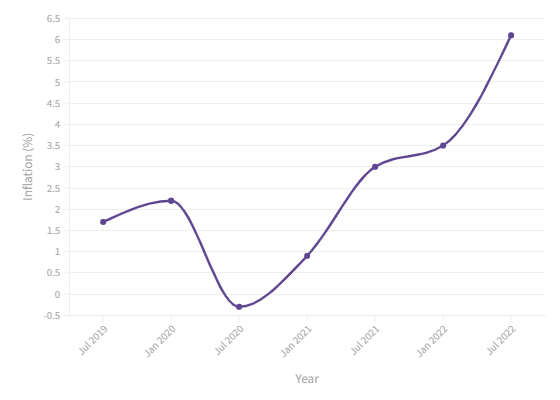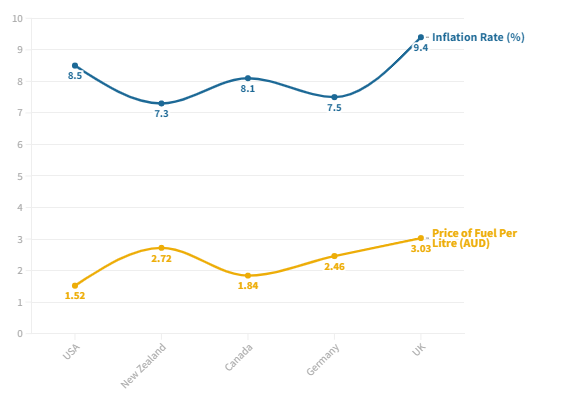A rising number of Australian households are being pushed beyond their financial limits as the cost of living rises beyond people’s earning capacity.
Australians have become accustomed to the costs of living increasing over the course of the COVID-19 pandemic as prices for food, gas, petrol and rent have skyrocketed since the inflation rate peaked at 6.1 per cent in June.
A rise in the annual wage growth provided little hope for Aussies needing relief from the rising cost of living, as the Australian Bureau of Statistics (ABS) recorded a 2.4 per cent increase in the March quarter, a weary competitor for the soaring cost of living.
Australia’s Inflation Rate
(2019-2022)

Figure 1 – Australia’s Inflation Rate (2019 – 2022). Data collected from Australian Bureau of Statistics (ABS).
With the exception of the July 2020 quarter, Australia’s inflation rate has risen steadily over the course of the pandemic, growing from 1.7 per cent in July of 2019, to a 21-year high of 6.1 per cent in July 2022.
Due to the rising inflation, Australia’s wholesale electricity prices are now six times higher than they were in April 2021, with the Australian Energy Regulator passing on rising costs to households.
A rise in Australia’s Inflation rate has been caused primarily by impacts caused by the COVID-19 pandemic, and more recently, Russia’s invasion of Ukraine, which has pushed global oil, gas, and food prices up.
Like Australia, many other countries around the world have been impacted by the COVID-19 pandemic and Russia’s invasion of Ukraine in 2022.
Inflation and Fuel Around the World
2022 Figures

Figure 2 – Inflation Rates and Fuel Prices from countries around the world. Taken from multiple sources.
The USA’s inflation rate rose to 8.5 per cent this year, with its consumer price index rising to 9.1 per cent in June; a 40-year high, according to the Department of Labour.
New Zealand’s inflation rose to 7.3 per cent in 2022, according to Stats NZ, caused by increasingly rising costs throughout the year, including housing construction and rental prices.
Canada experienced the largest yearly change to its Consumer Price Index since 1983, reaching 8.1 per cent in June.
Germany’s current inflation rate is at 7.5 per cent, steadily dropping month by month since May.
According to the United Kingdom’s Office for National Statistics, the country’s Consumer Price Index figure for June was the highest annual CPI inflation rate since 1997.
Rising inflation figures around the world represent how supply chain interruptions and international events cause prices to rise.
More persistent changes in inflation may be likely to occur as people and businesses change their expectations about future price movements and demand higher wages or pass on cost increases to customers and consumers.

